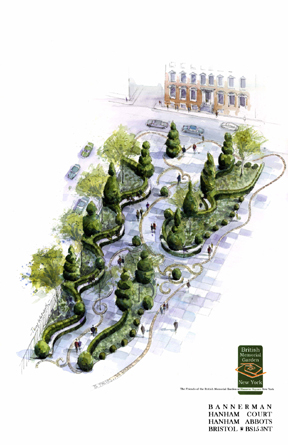The Queen Elizabeth II September 11th Garden
The Daily Plant : Wednesday, April 21, 2004
HANOVER SQUARE GETS BRITISH MAKEOVER

When British rule ended in the United States, New Yorkers celebrated by giving all the streets and parks new American names. But some of the old names stuck, even if only in popular usage. Chelsea remained Chelsea, Greenwich Village stood by Greenwich Village, and Hanover Square wouldn’t be known as anything but Hanover Square. Now, after over 200 years holding fast to its British name, Hanover Square will be remodeled to reflect its heritage. In partnership with the British Memorial Garden Trust, Parks & Recreation will be renovating the square, creating a brand new garden in the English tradition and bringing much-needed greenery to the downtown area.
Plans for Hanover Square’s renovation have been ongoing for the past two years. The site was first adopted in 2002 by the British Memorial Garden Trust, a non-profit formed to support renovations to Hanover Square. The British Memorial Garden Trust began the planning process by sponsoring two invitational competitions for the design of Hanover Square—one for the garden and one for a sculpture to be showcased within the garden. Julian and Isabel Bannerman, a British landscape architectural team, won the garden design competition. Their design combines classic English garden typologies, such as topiaries, floral displays, and running water. The winner of the sculpture competition was British artist Anish Kapoor. Carved from a massive block of pure black granite, Kapoor’s "Unity" sculpture will stand six meters high at the southern end of the park, complementing the garden’s overall design.
Hanover Square’s design is being remodeled with the guidance of Signe Neilson, a landscape consultant who has worked with Parks & Recreation on many renovation projects, including Verdi Square, Union Square, Owl’s Head Park, Inwood Hill Park, and Fort Washington Park. Nielson’s job is to adapt the Bannermans’ design so that it can withstand the pressures of urban life and accommodate Kapoor’s sculpture.
"The Bannermans—who typically design private English gardens—did not make their design with the city in mind," explained Nielson. "Hanover Square is a challenging space. Our planting beds are shallow and cannot support some of the plants the Bannermans suggested. There are also lighting and space constraints to keep in mind, as well the daily wear and tear of vehicle and pedestrian traffic."
Nielson and her team are currently working with the Bannermans to create a new design that will survive city life, while staying true to the Bannermans’ original aesthetic. They’ve incorporated new elements for the park’s protection, such as fencing and curbs. They’ve also adjusted the height of the topiaries so as to better display Kapoor’s sculpture. Most of the park’s materials will be imported from England, including the benches, paving stones, railings, and fountain. The plant materials, a balance of seasonal and permanent plantings, have been chosen to reflect the simple palette originally selected by the Bannermans. Roses might also be incorporated into the overall design, using heirloom seeds taken from Hampton Court Palace in England and donated by Her Royal Highness, Princess Anne, the Princess Royal.
"The most interesting part of the project is trying to invoke a historic feeling without using historic materials," said Nielson. "The history that is being invoked here is the long relationship between the United States and the United Kingdom. When complete, we hope the park will speak in a positive sense of the durability and the emotional connection between the two countries."
QUOTATION FOR THE DAY
"Green how I want you green.
Green wind. Green branches."
Federico García Lorca
(1898–1936)
Check out your park's Vital Signs
Clean & Safe
Green & Resilient
Empowered & Engaged Users
Share your feedback or learn more about how this park is part of a
Vital Park System



